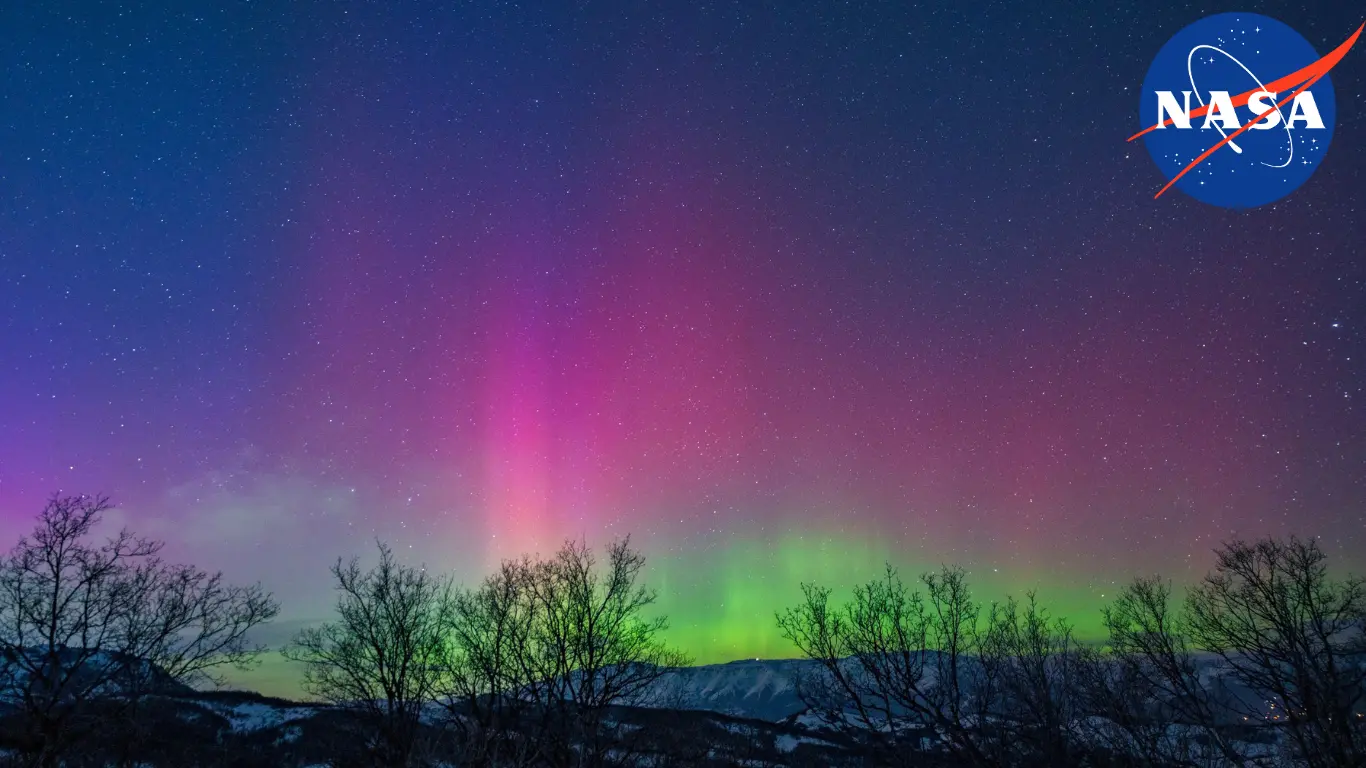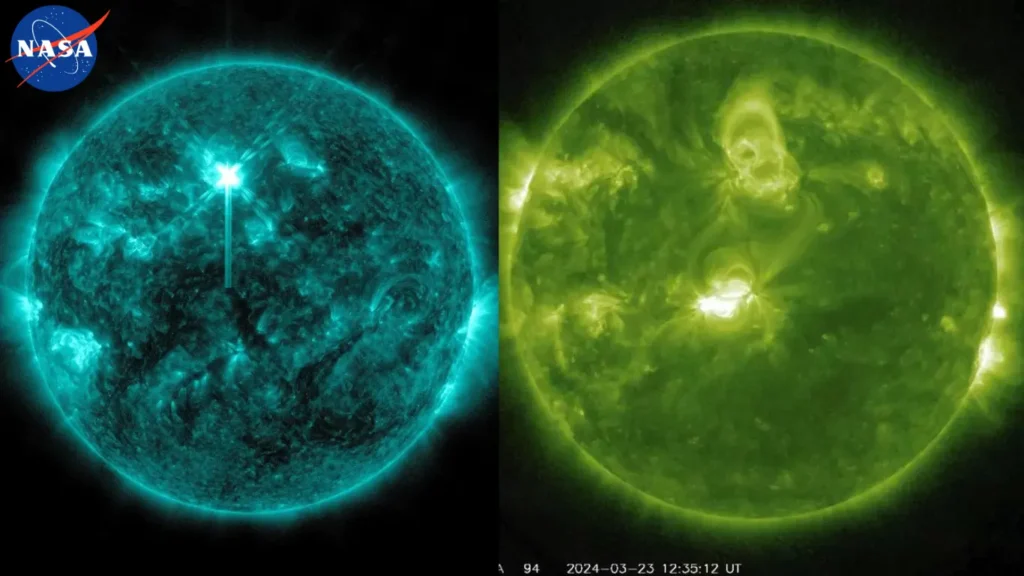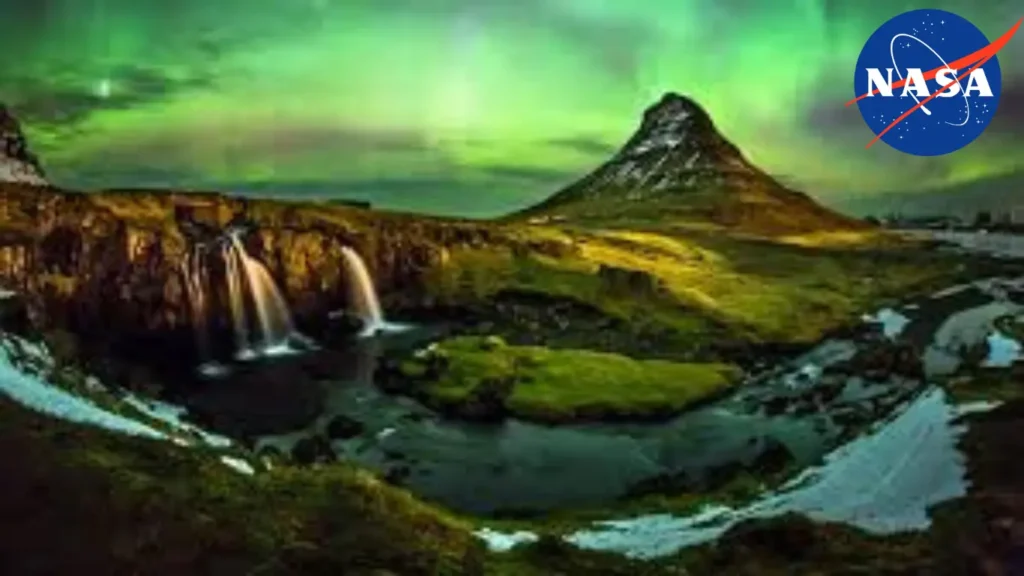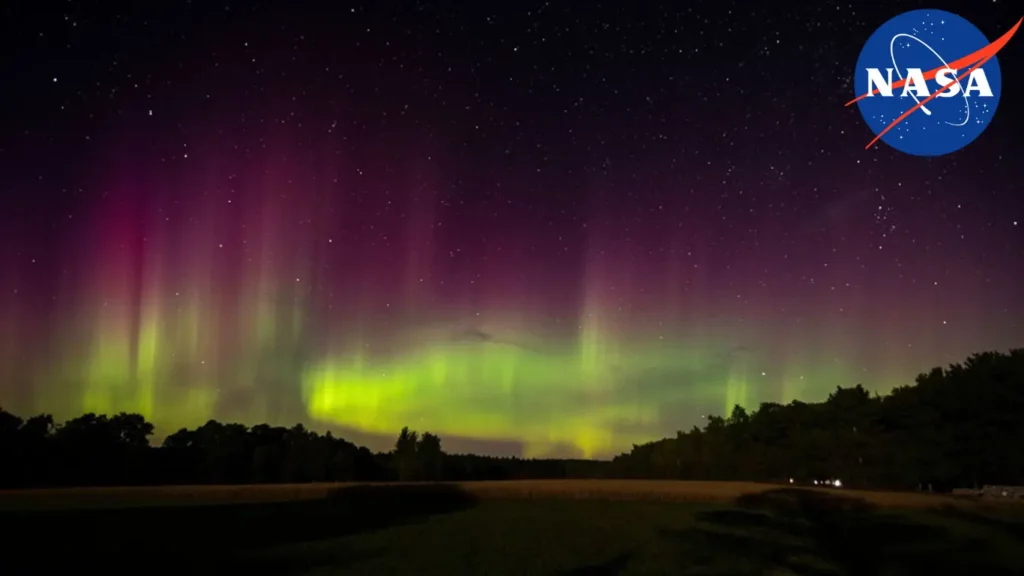News
Northern Lights to Paint USA Sky, Rare Spectacle Expected This Weekend

A bunch of solar flares and coronal mass ejections (which are basically big bursts of solar material) from the sun are happening. They could make some super cool auroras, like the Northern Lights. That might show up even in places like Alabama and Northern California.
People are awaiting this entertaining moments as they are waiting for this release.
But there’s a flip side, these solar activities might mess with communications here on Earth. Which starting tonight and lasting through the weekend. This info comes from the Space Weather Prediction Center, part of the National Oceanic and Atmospheric Administration.
The National Weather Service has a division called the Space Weather Prediction Center. They’ve put out a serious warning about a geomagnetic storm that might hit on Friday evening. This storm could be a big deal. In fact, it’s the first time they’ve issued a warning like this since way back in January 2005.
On Friday afternoon, the scientists at the Space Weather Prediction Center noticed something big happening in Earth’s magnetic field. They’re calling it a G4 or severe geomagnetic storm, which is pretty serious. In fact, it’s rated at level 4 out of 5 in terms of severity.
The Space Weather Prediction Center spotted signs of the severe geomagnetic storm at 12:37 p.m. Eastern Time. At this time skies will shine with Northern lights.

These signs traveled all the way from the sun. Before reaching satellites that keep an eye on space weather from a distance of 1 million miles (about 1.6 million kilometers) away from Earth.
As the sun gets closer to reaching the peak of its 11-year cycle, which scientists call solar maximum. Later this year, researchers have noticed something interesting. They’ve been seeing more and more powerful solar flares shooting out from the sun.
When the sun gets more active, it sets off a chain reaction that creates beautiful auroras. Those dazzling light shows we see near the Earth’s poles. Up north, we call it the northern lights, or aurora borealis, and down south. It’s the southern lights, or aurora australis.
Here’s how it works, when the sun sends out a bunch of charged particles during events like coronal mass ejections. These particles eventually make their way towards Earth’s magnetic field. When they get here, they mix it up with gases in our atmosphere. That’s when the magic happens, producing those stunning colors that dance across the sky.
Since Wednesday, the Space Weather Prediction Center has been keeping a close eye on the sun. They’ve noticed something pretty intense. A bunch of strong flares shooting out from a big group of sunspots on the sun’s surface. These sunspots are no joke they’re a whopping 16 times bigger than Earth.
Scientists have been busy watching the sun, and they’ve spotted something interesting: at least seven coronal mass ejections (CMEs). These are like huge clouds of ionized gas, also known as plasma, along with magnetic fields. That shoot out from the sun’s outer atmosphere.
And get this they’re all heading straight towards Earth. These big bursts of solar energy are expected to keep happening until Sunday.
The Space Weather Prediction Center uses a scale to measure three main things, solar flares that can mess with high frequency radio signals, geomagnetic storms, and solar radiation storms. Right now, the sun’s activity is so intense that it could trigger a solar radiation storm. Shawn Dahl, who coordinates services at the Space Weather Prediction Center, gave the heads up about this.
Shawn Dahl explained that the current solar radiation storm falls on the lowest end of their scale. While it can cause some issues for rocket launches and satellite operations, it’s not considered too serious at the moment. They believe they can manage it fine.
However, there’s always the chance that stronger events could happen, so they’re keeping an eye out to see if anything more significant occurs.
According to forecasts from the center, the most intense part of the geomagnetic storm could hit Earth sometime between 2 a.m. and 5 a.m. Eastern Time on Saturday. The center has labeled this occurrence as “an unusual event.” They’ve noted that there have only been three geomagnetic storms since December 2019, but all of them were relatively weak, according to their assessment.

In the past few months, geomagnetic storms triggered by the sun have led to some extraordinary sightings of auroras in places where they’re not typically seen. These include sightings as far south as New Mexico, Missouri, North Carolina, and California in the United States, and even in the southeastern region of England and other parts of the United Kingdom.
One notable event occurred when a solar storm caused a stunning aurora australis, the southern lights, to illuminate the sky over New Zealand at around 6:20 a.m. local time.
Depending on where you are, you might not always see the auroras directly overhead. But don’t worry experts advise keeping an eye on the horizon too. Because sometimes you can catch a colorful display there as well.
And here’s a handy tip even if you can’t see the auroras with your own eyes, the experts at the center suggest snapping some pictures of the sky with your phone. Why? Because sometimes, the camera can capture things that are too faint for us to see without help.
Michael Liemohn, a professor of climate and space sciences and engineering at the University of Michigan in Ann Arbor, explained that if there’s a severe storm, chances are the aurora will be visible even in southern Michigan.
He suggested getting away from city lights to a spot with clear skies. From there, you should be able to catch sight of the aurora. Northern lights might appear as a green or red glow stretching across the sky.
Geomagnetic Storms Effects Explained:
When coronal mass ejections from the sun head towards Earth, they can lead to geomagnetic storms, which are big disruptions in Earth’s magnetic field.
These storms have serious effects on both things in near Earth orbit and stuff right here on the ground. They can mess with communication systems, power grids, navigation tools, radio signals, and even operations of satellites.
The Space Weather Prediction Center has given a heads up to the folks who run these systems so they can take steps to protect them.
The Space Weather Prediction Center has reached out to operators in these regions, advising them to take steps to reduce any potential impacts. These could involve dealing with issues like more frequent voltage control problems.
Operators will also be keeping an eye out for anomalies or problems with satellite operations, as well as the possibility of GPS signals being weaker or less reliable for longer periods.
In response to these warnings, operators are making sure that power lines are working as they should be, checking that they have backup equipment ready to go if needed, and putting a hold on any maintenance work that’s scheduled. This way, they’re aiming to minimize any disruptions caused by the geomagnetic storm.
“The important thing to remember,” Dahl emphasized, “is that we understand what’s causing any issues that might arise. This knowledge enables us to take the right actions to lessen and manage any potential problems.”
When coronal mass ejections reach Earth, they bring along their own magnetic fields. These fields can be so strong that they overpower power lines, causing electrical currents to flow unexpectedly.
That’s why operators will be keeping a close watch for any signs of this kind of activity, according to Rob Steenburgh, a space scientist at the Space Weather Prediction Center.
“When we’re discussing the effects on the power grid,” Dahl clarified, “we’re specifically referring to the high voltage transmission lines. That’s where these unexpected currents can build up. It’s not something you’d see on the lines running from a small transformer to someone’s home.” He explained further,
“The issue arises primarily with the high voltage transmission lines, which can lead to problems for the big transformers that manage distribution.”
Solar storms from the sun can also lead to radio blackouts and even pose dangers for manned space missions.
NASA has a team called the Space Radiation Analysis Group, and their job is to keep an eye on conditions for astronauts up on the International Space Station. If they notice that there’s a higher risk of radiation, the astronauts can shift to parts of the station that have better shielding to keep them safe.
The center also gave a heads up that more solar activity could mean that we’ll be dealing with geomagnetic storm conditions for the entire weekend.
Since the current solar cycle kicked off in December 2019, researchers have only recorded three severe geomagnetic storms, according to the center’s records.
Looking back, a particularly intense G5, or extreme geomagnetic storm, happened back in October 2003. This storm caused power outages in Sweden and damaged power transformers in South Africa, according to reports from the center.

Experts at the center admit they’re a bit on edge, but mainly because these kinds of events with Northern lights are pretty rare.
They liken the situation to getting ready for a summer storm: it’s a good idea to have some extra batteries and a weather radio handy in case of a power outage. However, they reassure that there’s no need for people to take any extraordinary precautions for space weather. They don’t anticipate any disruptions to internet or cellphone service.
And even if GPS signals are briefly affected, providers should be able to quickly regain lock on satellite signals, so any disruption shouldn’t last long, according to the experts at the center.
Understanding Solar Activity and Its Effects:
Every 11 years or so, the sun goes through cycles of low and high activity, which is tied to the number of sunspots on its surface. These sunspots are essentially areas where the sun’s magnetic fields are really strong, causing dark spots to form. Some of these spots can even be as big as Earth or even larger.
Throughout a solar cycle, the sun goes through phases from calm periods to intense, active ones. When it’s at its busiest, known as solar maximum, the sun’s magnetic poles actually flip. After that, things quiet down again during solar minimum.
We’re currently heading towards the peak of solar maximum, expected to happen in the middle to late 2024. But even after that, the sun will still be pretty active for a couple of years.
Teams at the Space Weather Prediction Center keep a close eye on all of this. They use data from observatories on the ground and in space, as well as magnetic maps of the sun’s surface and observations of its outer atmosphere in ultraviolet light.
All of this helps them figure out when the sun might send out things like solar flares and coronal mass ejections stuff that can mess with Earth’s space weather.
Solar flares are a big concern because they can mess with communications and GPS systems almost instantly. They mess with a part of Earth’s upper atmosphere called the ionosphere.
But it’s not just communication systems that can be affected. Energetic particles released by the sun during these events can also mess with electronics on spacecraft. And if astronauts aren’t properly shielded, they could be in trouble within anywhere from 20 minutes to several hours.
Then there are coronal mass ejections—big clouds of material hurled away from the sun. These can take anywhere from 30 to 72 hours to reach Earth. When they do, they can cause geomagnetic storms. These storms mess with satellites and can even create electrical currents in Earth’s upper atmosphere that travel through the ground. That can mess with electric power grids.
These storms can also throw commercial airline flights off course. Pilots are told to steer clear of Earth’s poles during geomagnetic storms because they can lose communication or navigation abilities.
We’ve seen some pretty extreme storms in the past. In 1989, one knocked out the power grid in Quebec. And way back in 1859, there was the Carrington Event, the most intense geomagnetic storm ever recorded. It was so strong that telegraph stations sparked and caught fire!
If something like the Carrington Event happened today, it could cause trillions of dollars’ worth of damage and leave some power grids down for a long time.
-

 Soccer6 months ago
Soccer6 months agoDutch Fans in Blackface to Imitate Ruud Gullit, One Agrees to Stop
-

 Soccer6 months ago
Soccer6 months agoEx Glamour Model Says Party with England Team Before Euros
-

 News8 months ago
News8 months agoDubai Flood, Rain Turns Desert to Aquarium🌧️🐠
-

 Soccer6 months ago
Soccer6 months agoArgentina vs Peru 2-0 Highlights & All Goals Copa America 2024
-

 Entertainment7 months ago
Entertainment7 months agoThe Try Guys’ Journey From Four to Two
-

 NBA6 months ago
NBA6 months agoCelebrate with the Boston Celtics: Parade and Traffic Updates
-

 Soccer6 months ago
Soccer6 months agoUEFA EURO 2024: Essential Guide and Key Information
-

 Soccer6 months ago
Soccer6 months agoVinicius Jr Scores Two Goals in Brazil’s Win Vs Paraguay in Copa America 2024














Pingback: Northern Lights Again Return near California-Oregon Border This Saturday - Sports Groovy